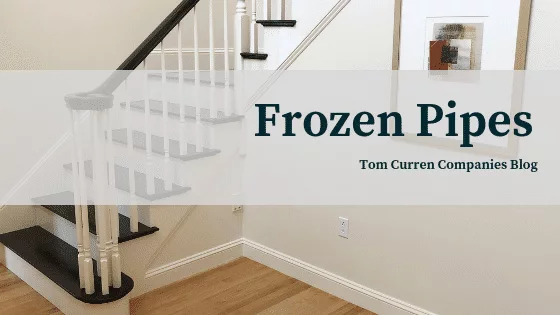Frozen Pipes

During winter months when temperatures drop, bursting water pipes are a major concern for home owners. Water pipes rupture because water expands as it freezes. Frozen water molecules take up more space than liquid water molecules and cause a buildup in pressure inside the pipe. When the pressure gets to be too great for the pipe to contain, it bursts. The flooding and water damage that result from a ruptured pipe can be quite costly. As with everything in life, it’s best to be smart and get ahead of any potential problems. The nightmare of bursting water pipes can be largely avoided with a few key preventative actions.
Firstly, find the potential troublemakers. Certain pipes are more susceptible to freezing than others, depending on their location in the home. The pipes that are most likely to freeze are located in exterior walls that have little or no insulation; exposed pipes in areas of the house that aren’t heated—basements, crawl spaces, attics, garages, kitchen cabinets; and any plumbing around the exterior of the house. Be extra vigilant with these areas. Water-damage, mold, and moisture build-up might be indications that certain pipes have frozen previously. This can be due to inadequate or improperly installed insulation. In these cases, it might be worth it to open the wall and better insulate the pipes.
When cold temperatures become extreme, open kitchen and bathroom cabinets enabling warmer air to circulate around the plumbing. Conversely, garage doors should remain closed if there are water supply lines in the garage, to prevent cold air from reaching them. Let water drip from faucets served by exposed pipes to help prevent them from freezing. Also, regulating the thermostat to the same temperature both during the day and night can keep pipes from freezing.
Don’t forget to disconnect, drain and store your garden hose before temperatures drop. A frozen garden hose can actually cause an interior pipe to burst. As water in the hose freezes it increases pressure throughout the entire plumbing system. Also, if your spigots are not frost proof, close the interior shut-off valve connected to the faucet, open and drain the spigot, and install a faucet insulator. Faucet insulators are inexpensive and completely worth it. Any type of insulation is better than nothing. Even newspaper can protect and insulate pipes to a certain extent.
Worst case scenario, your pipe has burst. What do you do now? First things first, act fast to minimize the damage. Stop the water. Every home owner should know where the stop tap is on the water main. It is usually under the kitchen sink, or where the main service pipe connects to the house. After the water is off, drain the pipes by running the cold water from the faucets and flushing the toilets. Next, turn off the hot water heater, then proceed to run the hot water from the faucets until there is no more running tap water. Next, locate the broken pipe and inspect the damage. Some people are handier than others and may be able to repair a burst non-main pipe on their own. However, it’s not a bad idea to call in a plumbing company. After the plumber pays a visit, call a professional remediation company. Unfortunately, cleaning your home after a pipe has burst isn’t as simple as using a towel. Remediation companies specialize in removing the wet affected areas, and drying out the space to prevent harmful mold and mildew from forming. They extract excess water with high-powered pumps and wet/dry vacuums. Then, they set to work on the structural drying process. It can be difficult to know which areas need to be dried if you’re not an expert. Water can settle into every nook and cranny. Water damage restoration can involve cutting open and ripping out walls and ceilings. After the remediation work you’ll want to have the walls and ceilings repaired, painted etc- which our company can assist with!
READ OUR
Related Articles
Locations






